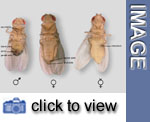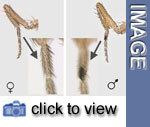Female vs. male
 In
order to do a cross you will need to distinguish males from females. How
to recognize a female? How to recognize a male? (If you are looking through
a dissecting scope, be fast - flies don’t like to be exposed to the
heat of the microscope lamp for too long.) The females are on average bigger
than males. However, since the difference in size is not significant, you
will have to use further cirteria.
In
order to do a cross you will need to distinguish males from females. How
to recognize a female? How to recognize a male? (If you are looking through
a dissecting scope, be fast - flies don’t like to be exposed to the
heat of the microscope lamp for too long.) The females are on average bigger
than males. However, since the difference in size is not significant, you
will have to use further cirteria.  The
abdomen of males bear a round termini exhibiting a brownish genital apparatus
on the the ventral side. Females have a pointed abdomen that displays a
less noticable genital apparatus on the ventral side. In the male situation
the two posteriormost sternits (dorsal cuticle plates) visible from the
dorsal side are completely black, while in females only the last visible
segment is black.
The
abdomen of males bear a round termini exhibiting a brownish genital apparatus
on the the ventral side. Females have a pointed abdomen that displays a
less noticable genital apparatus on the ventral side. In the male situation
the two posteriormost sternits (dorsal cuticle plates) visible from the
dorsal side are completely black, while in females only the last visible
segment is black.  A
very certain feature to distinguish males from females in the sex comb.
This dark comb-like structure of the basotarsus (the most proximal tarsal
joint) is only found on the male foreleg.With a little practise, Drosophila
males and females can be easily recognized.
A
very certain feature to distinguish males from females in the sex comb.
This dark comb-like structure of the basotarsus (the most proximal tarsal
joint) is only found on the male foreleg.With a little practise, Drosophila
males and females can be easily recognized. In order to perform crosses, you will have to use females that were not fertilized prior to the intended cross. In this case you will have to collect virginal females (in diagrams indicated as a female sign with a little "v" on top:
Safest method: clear all flies from the culture vial and then wait for a few hours. This depends on the temperature At 25°C it takes 4-6 hours before a male is sexually mature, at 18°C you have about 20 hours. Thus, separate all females eclosed within this timeframe from males. It is no problem to keep flies at 4° for a short time, this sometimes helps when you collect a large number of virgins.
Otherwise you have to rely on the following phenotypic characteristics:
Media list